5 Mind-Blowing Facts About Burj Khalifa
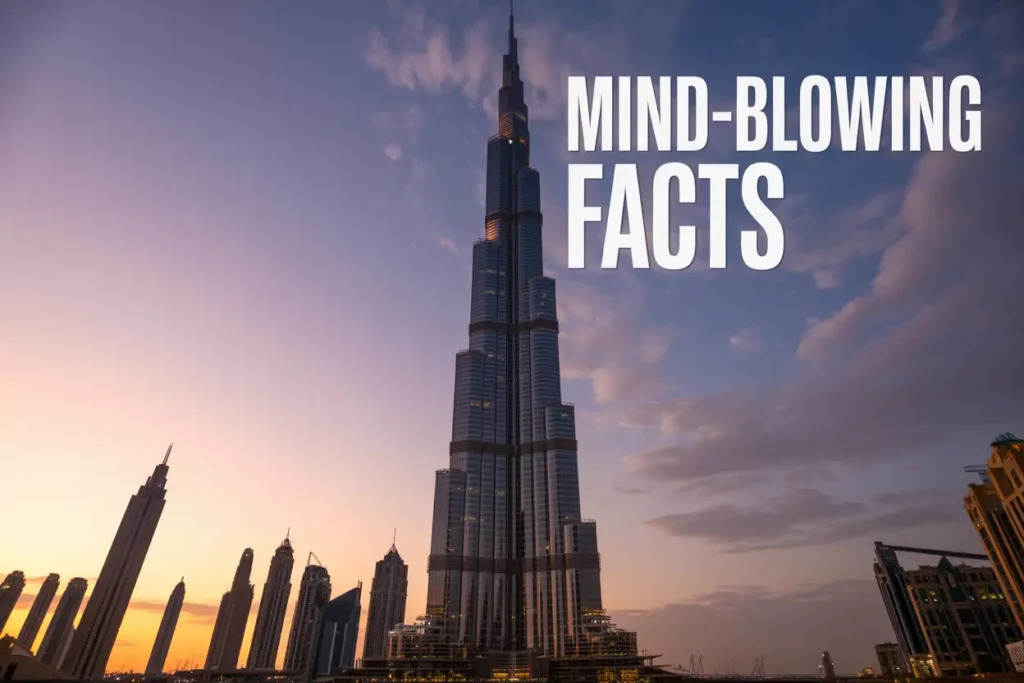
The Burj Khalifa stands as more than just the tallest building in the world. It’s a tower that seems to bend the rules of what’s physically possible. If you’re fascinated by Dubai architecture marvels or love discovering Burj Khalifa secrets that most people never learn about. You’re about to have your mind completely blown.
This guide is perfect for architecture enthusiasts. Dubai travelers, and anyone who gets excited about incredible engineering feats that push human limits. We’re talking about a skyscraper that creates its own weather patterns and houses elevator technology.
You’ll discover how this Dubai skyscraper defies basic physics in ways that still puzzle engineers today. We’ll explore the wild temperature differences between the bottom and top floors that literally create two separate climates in one building. Plus, we’ll reveal the jaw-dropping elevator speeds that make most people question if they’re even still on Earth.
Get ready to learn amazing facts about Burj Khalifa that will completely change how you think about what humans can actually build.
The Building That Defies Physics and Engineering Logic.
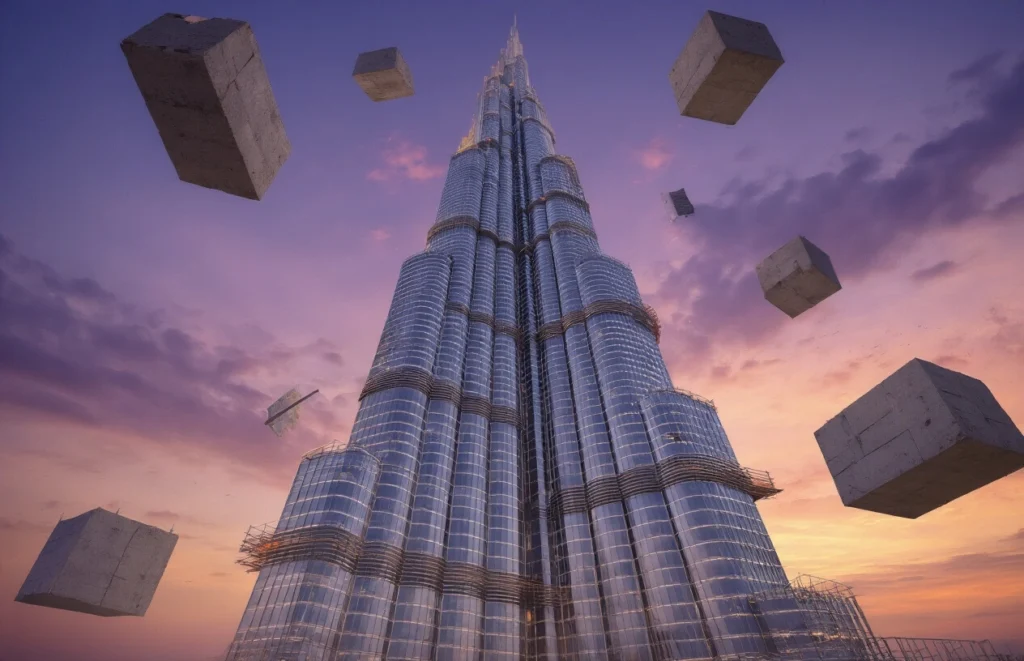
How Burj Khalifa stands tall despite wind speeds that should topple it
The Burj Khalifa faces wind speeds that would destroy ordinary buildings, yet it stands completely unmoved. At 828 meters tall, this Dubai skyscraper encounters winds exceeding 200 km/h at its peak, forces that should theoretically send it crashing down. The secret lies in its brilliant spiral design that literally tricks the wind.
The building’s shape changes as it rises, creating a twisted profile that breaks up wind patterns before they can build dangerous momentum. Instead of hitting a flat surface that creates devastating pressure, winds spiral around the structure and lose their punch.
Even more impressive, the tower actually moves slightly in strong winds – up to 1.5 meters at the top. This isn’t a design flaw; it’s genius engineering. The building sways like a flexible reed rather than standing rigid like a tree that snaps in a storm. Advanced dampers and the building’s own weight distribution create a perfectly balanced system that absorbs and dissipates wind energy rather than fighting it.
The secret foundation that goes deeper than most skyscrapers are tall
Most people admire the Burj Khalifa facts about its height, but the real engineering miracle happens underground. The foundation extends 50 meters below ground level – deeper than many 15-story buildings are tall. This isn’t just digging deep for the sake of it; it’s a carefully calculated feat that required moving over 500,000 cubic meters of earth and rock.
The foundation system consists of a massive concrete raft supported by 194 concrete piles, each one drilled to different depths based on the soil conditions at that exact spot. Some piles reach depths of 70 meters, hitting bedrock that hasn’t moved in millions of years. The concrete pour for the foundation alone took 36 hours straight, requiring a constant stream of concrete trucks to prevent any weak joints from forming.
What makes this Dubai architecture marvel even more incredible is the foundation’s ability to distribute the building’s 500,000-ton weight across the desert sand without sinking. The engineers had to account for Dubai’s challenging soil conditions – layers of sand, clay, and rock that shift and settle differently. They created a foundation so robust that it could theoretically support a building twice as tall as the current structure.
Revolutionary materials that bend reality without breaking
The Burj Khalifa construction pushed material science to its absolute limits. The concrete used in this tower isn’t ordinary concrete – it’s a space-age mixture that can withstand temperatures from -40°C to 50°C without cracking. This special concrete contains additives that make it stronger than some steel, yet it can flex enough to handle the building’s natural movement.
The exterior cladding system represents another breakthrough in Dubai tower engineering. Over 26,000 glass panels cover the building, each one individually cut and positioned. These aren’t regular windows – they’re made from specially treated glass that reflects heat while allowing perfect visibility. The aluminum and steel framework that holds these panels can expand and contract by several centimeters as temperatures change throughout the day, yet never loses its structural integrity.
Perhaps most mind-bending is the building’s steel framework. The tallest building in the world uses a special grade of steel that maintains its strength even when heated to extreme temperatures. This steel can actually bend up to 15 degrees without permanent deformation, allowing the entire structure to flex during high winds or temperature changes while snapping back to its original position perfectly every time.
Temperature Variations That Create Two Different Worlds
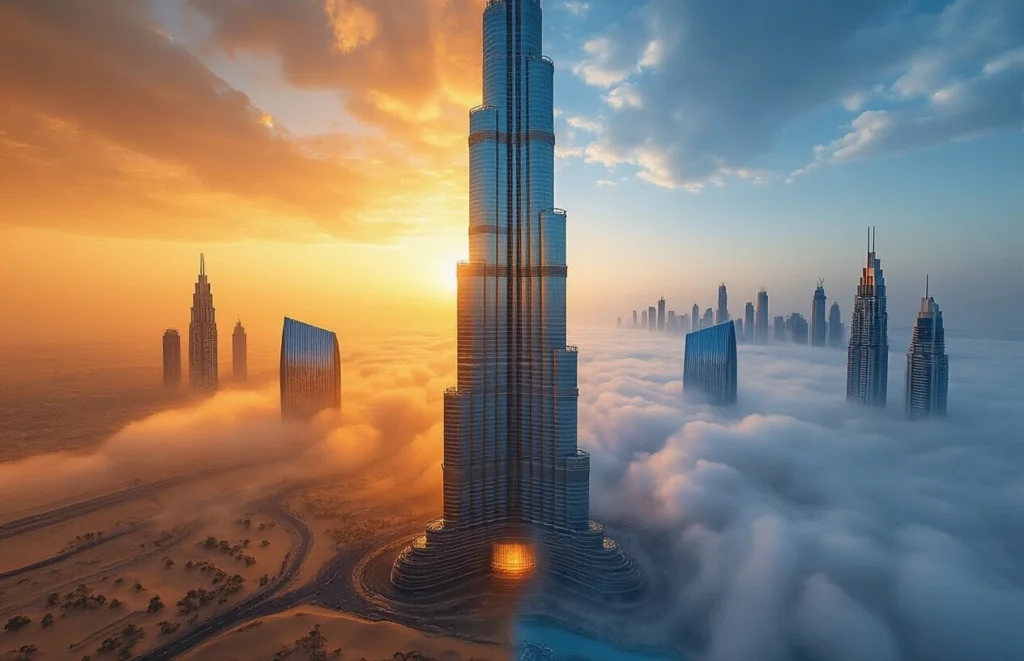
Why the top floors experience different seasons than the bottom
The Burj Khalifa secrets extend far beyond its impressive height. Picture this: residents on the 124th floor might be enjoying a pleasant 75°F evening while people at ground level swelter in 85°F heat. This isn’t science fiction – it’s the reality of living in the tallest building in the world.
As you climb higher in Earth’s atmosphere, temperatures drop approximately 2°F for every 1,000 feet of elevation. At 2,717 feet tall, the Burj Khalifa facts reveal that the top floors naturally experience cooler temperatures year-round. During Dubai’s scorching summer months, this elevation effect becomes a literal lifesaver for upper-floor residents.
The 10-degree temperature difference that changes everything
Weather monitoring systems throughout the Dubai skyscraper engineering marvel consistently record temperature variations of 8-10°F between the base and crown of the building. This dramatic difference creates unique microclimates within the same structure.
The temperature variations affect more than just comfort:
- Air conditioning costs: Upper floors require significantly less cooling
- Humidity levels: Lower humidity at higher altitudes creates different living conditions
- Wind patterns: Upper floors experience stronger, more consistent breezes
- Weather events: Fog and low clouds sometimes engulf middle floors while the top remains clear
| Floor Range | Average Temperature Difference | Climate Characteristics |
| 1-50 | Baseline | Hot, humid Dubai climate |
| 51-100 | -4°F to -6°F | Moderate reduction in heat |
| 101-163 | -8°F to -10°F | Noticeably cooler, less humid |
How residents live in completely different climates within the same building
Living in the Burj Khalifa means adapting to your specific altitude zone. Residents on floors 100 and above often keep light jackets handy for stepping onto their balconies, while ground-floor retail workers dress for typical Dubai heat.
The building’s HVAC systems account for these variations with zone-specific climate control. Each section operates almost independently, creating customized environments. Upper-floor residents report wearing sweaters during winter months – something unthinkable at street level in Dubai.
This Dubai architecture marvel essentially houses multiple climate zones, making it one of the most fascinating examples of how extreme height creates distinct living environments within a single structure.
The Elevator System That Breaks All Speed Records
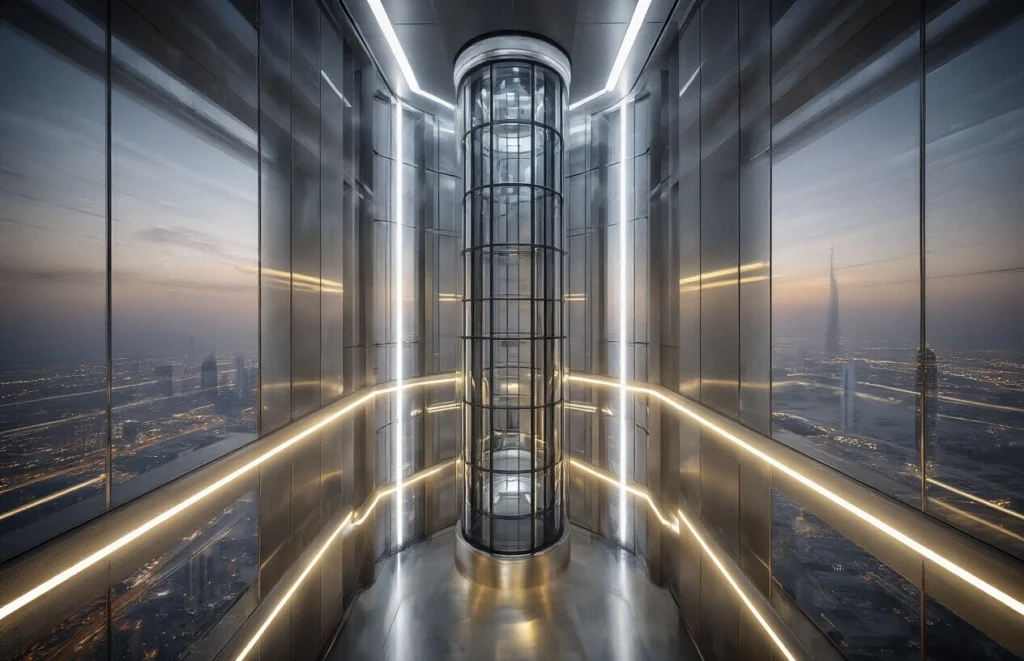
Traveling faster than most cars on highways while going vertical
The Burj Khalifa elevators rocket upward at speeds that would make your daily commute feel like a crawl. These vertical speed demons can reach up to 10 meters per second (22 mph), which means you could travel from the ground floor to the observation deck on the 148th floor in just about 60 seconds. To put that in perspective, these elevators move faster than many city buses and match the speed limit in most residential neighborhoods.
What makes this speed even more remarkable is the precision required to maintain it. The Dubai skyscraper engineering team had to account for wind sway, temperature fluctuations, and the building’s natural movement when designing these high-speed vertical transportation systems. The elevator cables alone stretch over 500 meters in some shafts, creating their own engineering challenges as they expand and contract throughout the day.
The technology that prevents your ears from popping during the journey
Riding these rockets to the sky should theoretically leave your ears feeling like you’ve taken off in an airplane, but the Burj Khalifa facts reveal something incredible: most passengers experience minimal discomfort. The secret lies in sophisticated pressurization technology borrowed from the aerospace industry.
Each elevator car features active pressure regulation systems that gradually adjust the cabin pressure as you ascend. Smart sensors monitor the rate of altitude change and automatically release or add air pressure to match your body’s natural adaptation rate. The elevator doors are sealed with rubber gaskets similar to those found in aircraft, creating a controlled environment that protects passengers from rapid pressure changes.
The ventilation systems also play a crucial role, circulating air at precise rates to prevent that stuffy, uncomfortable feeling you might expect during such a rapid ascent.
Why some elevators skip entire sections of floors
Not all elevators in this tallest building in the world serve every floor, and this isn’t a design flaw – it’s genius engineering. The building uses a sophisticated zoning system where different elevator banks serve specific sections of floors. Some elevators are programmed to skip floors 1-39 entirely, shooting straight up to serve only the upper residential and office zones.
This zoning approach prevents bottlenecks and reduces wait times dramatically. Express elevators serve as vertical highways, moving people quickly between major zones, while local elevators handle traffic within specific floor ranges. The system includes double-deck elevators that can serve two floors simultaneously, effectively doubling capacity without increasing the number of shafts needed.
The emergency systems that work when gravity becomes your enemy
When you’re suspended hundreds of meters above Dubai, backup systems become a matter of life and death. The Burj Khalifa elevator speed systems include multiple redundant safety features that kick in if the primary systems fail. Each elevator car has independent emergency brakes that engage automatically if the car exceeds safe speeds.
The most impressive feature is the emergency power system that can operate elevators even during complete power outages. Battery backup systems can run essential elevators for hours, ensuring that people aren’t trapped in cars or stranded on upper floors.
Emergency communication systems connect each car directly to building security, and specialized rescue elevators are designated specifically for emergency evacuations, capable of operating independently from the main elevator network.
Construction Mysteries That Challenge Human Capabilities.
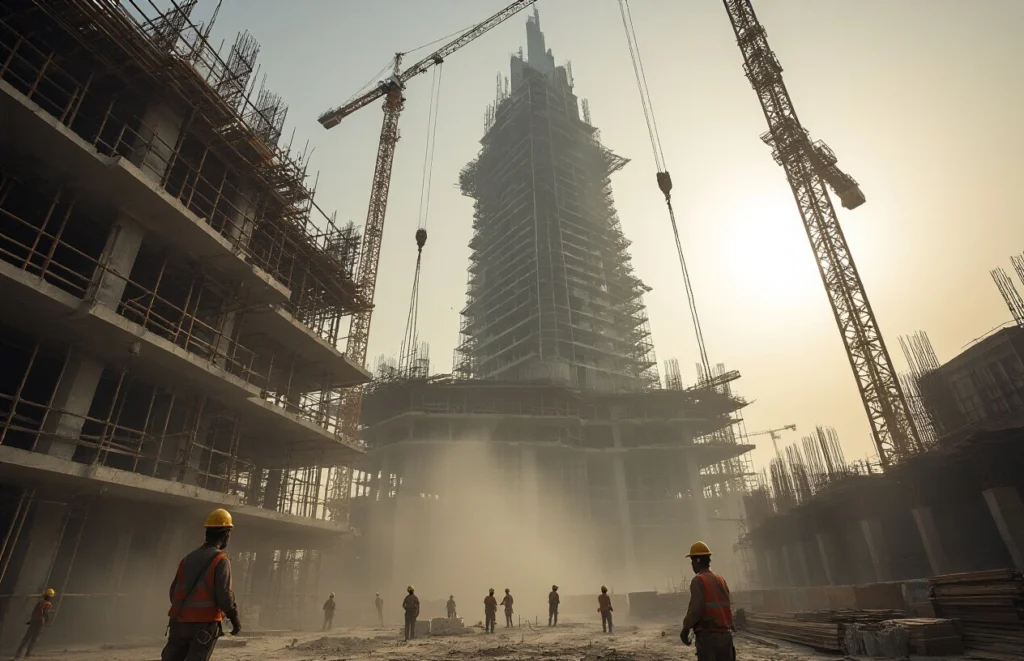
How Workers Built in Temperatures That Could Kill Them.
Working on the Burj Khalifa construction meant facing extreme desert heat that regularly soared above 104°F (40°C) during summer months. Construction crews had to battle conditions where touching exposed metal could cause instant burns, and dehydration became a life-threatening reality within minutes. Workers wore specialized cooling vests filled with ice packs and consumed up to 8 liters of water per shift just to survive. The concrete pouring process became particularly dangerous – fresh concrete in extreme heat would cure too quickly, creating structural weaknesses that could compromise the entire building’s integrity.
Moving materials 2,717 feet into the sky created unprecedented logistical challenges. Standard construction cranes couldn’t handle the height. Forcing engineers to design custom climbing systems that moved up as each floor was completed. A single concrete pour for the upper floors required 150 truck loads delivered in perfect sequence. Any delay meant the previous concrete would set improperly. Steel beams weighing several tons had to be precisely positioned using helicopter lifts when traditional methods failed. The transportation network included specialized conveyor systems. Multiple material hoists operating 24/7, creating a vertical supply chain unlike anything attempted before.
Dubai skyscraper engineering faced unique timing constraints that dictated when work could proceed. Concrete pours were restricted to night time hours when temperatures dropped below critical thresholds. Daytime heat would cause rapid moisture evaporation, creating weak spots in the structure. High winds during certain hours made crane operations impossible. Particularly above the 100th floor where wind speeds doubled compared to ground level. Prayer times required complete work stoppage five times daily. Demanding precise scheduling coordination across hundreds of workers from different cultural backgrounds.
The tallest building in the world came with a human price that often gets overlooked in architectural celebrations. Over 12,000 workers from 100+ countries labored in shifts around the clock for six years straight. Heat-related injuries occurred weekly, with some workers collapsing from exhaustion and severe dehydration. The psychological toll was equally severe – working at extreme heights while battling desert conditions created stress-related health issues that affected entire families. Safety protocols had to be constantly updated as new dangers emerged with each floor climbed, turning the construction site into a testing ground for extreme-environment construction techniques.
Hidden Features That Most Visitors Never Discover.
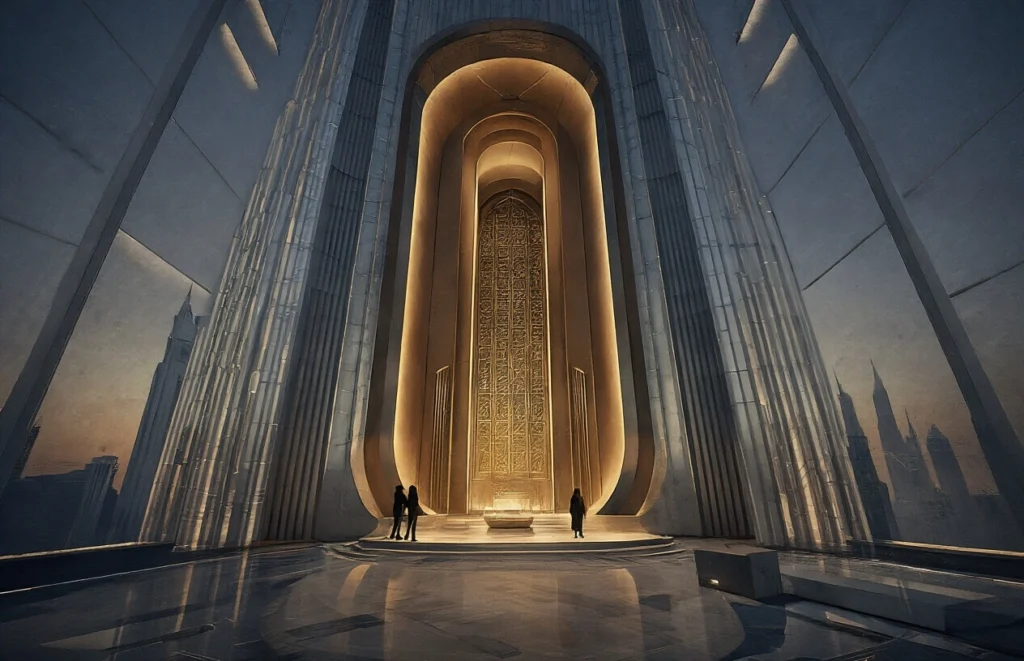
Deep within the Burj Khalifa exists a labyrinth of spaces that most people will never see or even know about. Floor 123 doesn’t technically exist on public building plans, yet it houses critical mechanical systems that keep the entire structure running. These phantom floors contain massive water tanks, electrical substations, and climate control equipment that would boggle your mind.
The building also features secret maintenance shafts that run parallel to the main elevator cores. These hidden pathways allow technicians to move throughout the structure without disturbing guests or residents. Some of these passages are so narrow that only specially trained personnel can navigate them, creating an almost spy-movie atmosphere within this architectural marvel.
What’s really wild is the existence of emergency command centers located on undisclosed floors. These rooms monitor everything from wind patterns to seismic activity, operating 24/7 with technology that rivals NASA’s mission control centers. The exact locations remain classified for security reasons, but they’re strategically positioned to coordinate responses to any conceivable crisis.
Standing on the Burj Khalifa’s observation deck on a crystal-clear day offers one of the most incredible experiences on Earth. You’re literally looking at the United Arab Emirates, Iran, and Saudi Arabia simultaneously. This unique positioning happens because Dubai sits at a strategic crossroads where these three nations converge across the Persian Gulf.
The view extends roughly 95 kilometers on perfect weather days. Which is far enough to catch glimpses of Iran’s mountainous coastline across the water. To the south and west, Saudi Arabia’s desert landscape stretches endlessly. While the UAE’s diverse terrain unfolds in every direction below.
Weather conditions play a huge role in this tri-country visibility. The best viewing happens during winter months when atmospheric clarity peaks and humidity drops significantly. Early morning hours, typically between 7-9 AM, offer the clearest sight lines before heat haze begins distorting distant views.
The Burj Khalifa moves constantly, swaying up to 1.5 meters at its peak during strong winds. Yet people inside remain completely oblivious to this motion. This engineering miracle comes from a sophisticated system called a tuned mass damper, essentially a massive counterweight that moves opposite to the building’s natural sway.
The structure’s Y-shaped design plays a crucial role in managing wind forces. Instead of fighting against wind pressure like traditional rectangular buildings, the Burj Khalifa’s aerodynamic profile actually channels air around its form. This reduces wind load by approximately 40% compared to buildings with sharp corners.
What makes this even more impressive is the building’s natural frequency. Engineers calculated precisely how the tower would vibrate in various wind conditions, then designed dampening systems to counteract these movements before they become noticeable to occupants. The result feels completely solid even when powerful sandstorms rage outside.
The Burj Khalifa’s emergency systems read like something from a futuristic movie. Pressurized refuge areas on every 13th floor can seal themselves completely, providing clean air and communication systems for hours during fire emergencies. These spaces feature independent power supplies and can maintain life support even when the rest of the building loses power.
The building’s firefighting system includes specialized elevators that remain operational during emergencies. These aren’t your typical elevators – they’re pressurized, fireproof capsules that can transport emergency responders to any floor even when regular elevators shut down. Each car carries its own oxygen supply and communication equipment.
Perhaps most mind-blowing are the building’s automated emergency protocols. Sensors throughout the structure can detect smoke, unusual heat patterns, or structural stress before humans even notice problems. When triggered, these systems automatically adjust air pressure, redirect elevator traffic, illuminate escape routes. And even communicate directly with Dubai’s emergency services. Providing real-time building status updates that help responders plan their approach before they even arrive.
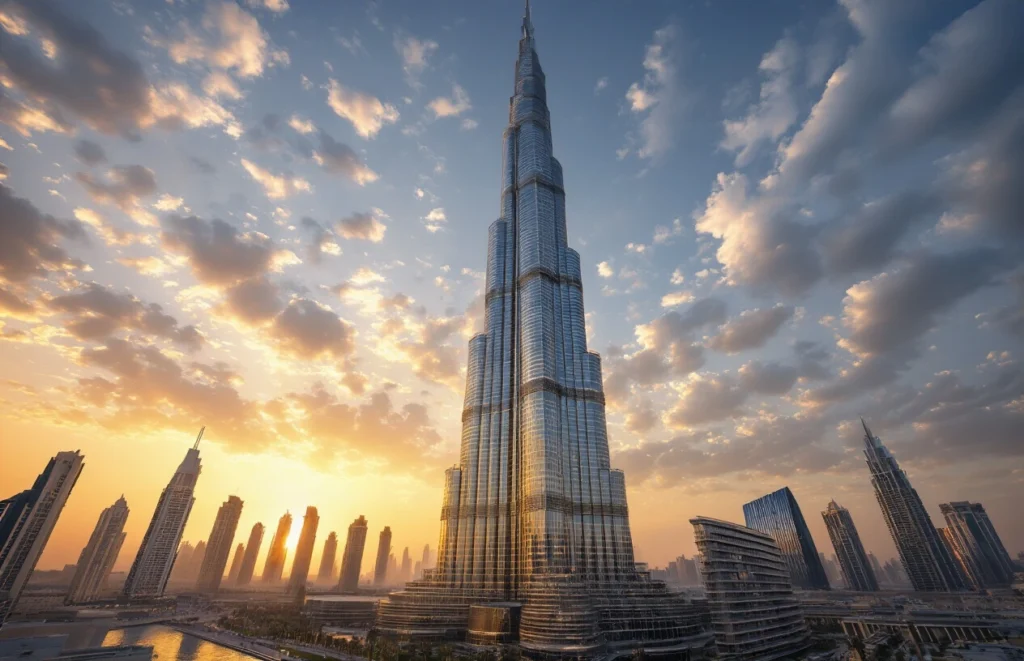
The Burj Khalifa stands as a testament to what happens when human ambition meets cutting-edge engineering. From its physics-defying structure to the dramatic temperature differences between its base and top floors. This architectural giant proves that reality can be stranger than fiction.
What makes this tower truly remarkable isn’t just its height. It’s all the hidden features and engineering marvels that most people never get to see or experience. The next time you look at the Burj Khalifa, remember that you’re witnessing more than just a tall building. You’re seeing proof that humans can create structures that challenge our understanding of physics, engineering, and even reality itself. Sometimes the most incredible facts are hiding in plain sight, towering over us at 2,717 feet.